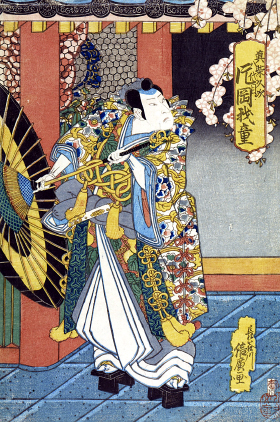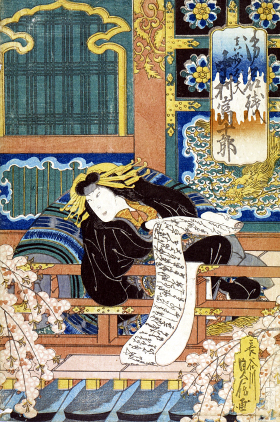| KEISEI HAMA NO MASAGO |
| Play titles | Keisei Hama no Masago The Courtesan Sands on the Beach [1] |
| Author | Nishizawa Ipp˘ |
| History |
Nishizawa Ipp˘'s drama "Keisei Hama no Masago" was premiered in the 1st lunar month of 1839, in ďsaka at the Kado no Shibai [casting]. This drama was very popular during the Edo period but went into oblivion during the Meiji era (only staged in ďsaka koshibai on rare occasions). It was successfully revived at the National Theatre in April 1981 [casting] and March 1994. It was decided for these two revivals to use real names for the historical figures, like Toyotomi Hideyoshi or Akechi Mitsuhide instead of the usual disguised names Mashiba Hisayoshi or Takechi Mitsuhide. It was planned to stage only the "Nanzenji Sanmon" scene (the Sanmon gate at the Nanzenji Temple) in January 1998 at the Kabukiza, with Nakamura Utaemon VI and Onoe Kikugor˘ VII in the roles of the keisei Ishikawaya Masagoji and Hisayoshi. Unfortunately, Nakamura Utaemon VI was too frail to perform it and "Onna Goemon" was replaced by "Onna Date". The opportunity to stage this scene as an independent act arose again ten years after, in January 2008 at the Kabukiza, with Nakamura Jakuemon IV and Nakamura Kichiemon II in the roles of the keisei Ishikawaya Masagoji and Hisayoshi (the stage name was used instead of the real name). |
| Structure |
The 1981 revival of "Keisei Hama no Masago" was made up of 4 acts divided into 10 scenes. |
| Key words |
Akechi Mitsuhide Ashigaru Ishikawa Goemon Ishikawa-goemonmono Jidaimono Jurakudai Katada Kaid˘ Keisei K˘ro Koshimoto Mashiba Hisaaki Mashiba Hisatsugu Mashiba Hisayoshi Miuke Nanzenji Oda Harunaga Oda Nobunaga Omamori ďmi Rant˘ Seppuku Taik˘ki Takechi Mitsuhide Toyotomi Hidetsugu Toyotomi Hideyori Toyotomi Hideyoshi Tsuzura Yodogawa Yodogimi Yodomachi Gozen |
| Summary |
Act I At the end of the sixteenth century, a peasant boy named Hiyoshimaru rose to the rank of general and was at the service of the great warlord Oda Harunaga, the military ruler of Japan. By defeating the rebel Takechi Mitsuhide, Hiyoshimaru succeeded in bringing peace to the country and changed his name to Mashiba Hisayoshi. The keisei Ishikawaya Masagoji has been hiding at the gate of the Nanzenji Temple. She is in reality Princess Satsuki, the daughter of Takechi Mitsuhide. She appears on the balcony of the gate and, looking down on the magnificent flowering cherry trees, reaffirms her intention of restoring the House of Takechi by overthrowing Hisayoshi. At that moment, a solitary pilgrim appears at the gate. He is Hisayoshi himself. Perceiving the real nature of Masagoji's ambitions, he has been secretly searching for her. She suddenly throws one of her luxurious hairpins at him but he easily stops it. They agree to meet again. Act II Mashiba Hisayoshi is now in Kyűshű preparing to launch an invasion against Korea. He has left the capital of Ky˘to in the hands of his adopted son, Mashiba Hisatsugu, who is living at the Juraku Palace, the headquarters of the Mashiba family. Also living in the palace are Hisayoshi's concubine, Yodomachi Gozen, and their natural son, Mashiba Hisaaki. Meanwhile, at the Nanzenji Temple, Oda Harunaga and other warlords have gathered to pray for victory in the imminent strike against Korea and also to check on the credentials and family trees of all the generals taking part in the coming military campaign. Hisatsugu is the object of considerable unpopularity at the moment, since he has unfortunately lost Hisayoshi's precious incense burner. Hisatsugu's retainer, Kishida Minbu, tries to defend his master but to no avail. In the absence of proper documents relating to his birth and family history, it appears that Hisatsugu is to be deprived of his place in the Mashiba family. Hisatsugu is mortified, but when the warlords have left, Minbu reveals the real facts concerning his background. It appears that he is descended from the noble Miyoshi family and was adopted by Hisayoshi before he left for Kyűshű. On hearing this, Hisatsugu hints that he will attempt to destroy his adoptive father and restore the House of Miyoshi. He abjures Minbu to silence. Act III On the Katada Highway in ďmi, a woman robber by the name of Goemon has been terrorizing the local people. She is, in fact, Gion no Okaji [2], the widow of the legendary thief Ishikawa Goemon. A loyal supporter of the rebel Takechi Mitsuhide, she received the custody of his daughter Princess Satsuki after his death, but they have become separated. Princess Satsuki is currently a courtesan and the sum of 1,000 ry˘ is necessary to redeem her (miuke). Okaji has assembled a band of thieves to rob passers-by in order to raise the money. Today they have collected the useful sum of 50 ry˘, which involved, however, slaying a child. When Okaji looks at the child's date of birth on a piece of paper in a good luck amulet (omamori) found in his body she is shocked to find that it is the same as that of her own son, Goroichi. The following day, a man who has been responsible for bringing up Goroichi, visits Okaji at her house to inform her that her son was killed the previous night. Okaji realizes that the child she robbed and killed was her own. At that moment Takechi Mitsuhide's nephew Sait˘ Kuranosuke arrives. He has been busy trying to raise the money to redeem Princess Satsuki and he has witnessed the murder of Goroichi the previous evening. Okaji indicates to them that the child's murderer is in a rear room. So saying, she deliberately falls on Goroichi's sword. Blood-stained, she confesses that it was her fate to kill her own son as retribution for her crimes. Kuranosuke vows to rescue Princess Satsuki and restore the house of Takechi. Act IV The magnificence of the Juraku Palace is a testimony of Hisayoshi's power and status as kanpaku. Taking advantage of his adoptive father's absence in Ky˘to, Hisatsugu has been spending days and nights in never-ending parties. Today he has called actors to a drinking party, but, getting out of hand, it deteriorates into a drunken brawl (rant˘) and swords are drawn. Kishida Minbu and Takayama Ukon look on sadly, Yodomachi Gozen appears accompanied by Maeda Toshiie, a messenger from Hisayoshi. In view of his scandalous behaviour, Hisatsugu is ordered to commit seppuku. There is much astonishment at this, but Maeda Toshiie, in league with Hisatsugu, suggests that Takayama Ukon die instead. Ukon bears a strong physical resemblance to Hisatsugu so they stand a reasonable chance of deceiving Hisayoshi. Hisatsugu's sister Princess G˘ and the koshimoto Tokiwagi are both in love with Takayama Ukon but since he is likely to die at any moment, he is in no mood to respond to their advances. Meanwhile, Yodomachi Gozen is distressed at the foolish behaviour of her son by Hisayoshi, Hisaaki, who spends day after day dallying with the palace concubines. At this rate he is unlikely to succeed to the position of leader of the Mashiba clan. At that moment an Imperial Messenger arrives with instructions that Hisaaki is shortly to marry General Kureha's daughter Princess Kokonoe. Kishida Minbu is suspicious of the Messenger and gradually moves closer. The Messenger turns out to be the courtesan, Masagoji, in love with Hisaaki. She has entered the palace in disguise in order to meet him. Minbu tells her that will be possible on condition that she hand over the missing incense burner (k˘ro). In a rear room Yodomachi Gozen also bargains for the incense burner by promising to let her meet Hisaaki. Surrounded by concubines, Hisaaki himself appears. Pretending to join in the game, Ishikawaya Masagoji takes the opportunity of stealing a scroll from the library. In the Great Hall, Hisatsugu has heard that Princess G˘ and Ukon are in love and is determined to kill them both. Kishida Minbu restrains Hisatsugu from this barbaric double murder and allows Ukon and Princess G˘ to escape. Maeda Toshiie and Yodomachi Gozen arrive with further orders from Hisayoshi. Since Hisatsugu's conduct gives every indication of turning into full-scale revolt against Hisayoshi, he is ordered to commit seppuku without further ado. Hisatsugu, however, declares that he has never had any intention of obeying the order. Rather, he announces his intention of killing Hisayoshi and restoring the House of Miyoshi. Hearing this, Minbu realises that there is no time to lose. He kills Hisatsugu and pretends to pierce his own stomach. Maeda is impressed by Minbu's valour and departs immediately to inform Hisayoshi. With all the koshimoto intent on watching Minbu, Ishikawaya Masagoji takes the opportunity of fleeing the palace with Hisaaki. Yodomachi Gozen is momentarily dazed. With Hisatsugu dead and Hisaaki fled, the Mashiba clan seems in danger of extinction. At that moment Kishida Minbu suddenly revives, leaps to his feet and jubilantly declares the downfall of the Mashiba clan to be at hand. Minbu is in reality Shih˘ten Tajima-no-Kami [3], a faithful retainer of Takechi Mitsuhide. Ever since the death of his master at the hands of Hisayoshi, he has been plotting the downfall of the Mashiba clan. However, at a sign from Yodomachi Gozen, Maeda Toshiie and Takayama Ukon appear with other Mashiba supporters and surround Tajima-no-Kami. It turns out that they have long been suspicious of him and were waiting for the chance of denouncing him. Yodomachi Gozen's joy is short-lived, however. Tajima-no-Kami, together with a palace ashigaru named Kinz˘ (in reality the warrior Yasuda Sakubŕ), overwhelms the Mashiba forces. According to a previously arranged plan to divert the course of the Yodo River, they give the signal to flood the palace. The magnificent building is inundated. Making use of magic powers, Tajima-no-Kami causes the boat in which Masagoji and Hisaaki, concealed in a large basket (tsuzura), were escaping to come back. Masagoji is actually the daughter of Takechi Mitsuhide. She and Tajima-no-Kami recognize each other as mutual enemies of Hisayoshi. Tajima-no-Kami is cut down by the enemies, but not before he has transmitted his magic powers to Masagoji. The flooding of the palace continues. The boats containing Yodomachi Gozen and Yasuda Sakubŕ and Masagoji draw together. Casting a spell, Masagoji causes the basket containing Hisaaki to rise into the sky and disappear and then slowly follows suit herself. |
| Notes |
[1] The title "The Courtesan Sands on the Beach" comes from the 2nd volume of "Kabuki Plays On Stage". [2] Literally Okaji from Gion. |
 |
 |
| The actor Kataoka Gad˘ II playing the role of Mashiba Hisatsugu in the drama "Keisei Hama no Masago", which was staged in the 1st lunar month of 1839 at the Kado no Shibai (print made by Hasegawa Nobuhiro) | The actor Nakamura Tomijűr˘ II playing the role of the keisei Ishikawaya Masagoji in the drama "Keisei Hama no Masago", which was staged in the 1st lunar month of 1839 at the Kado no Shibai (print made by Hasegawa Sadanobu I) |
|
|
| Contact | Main | Top | Updates | Actors | Plays | Playwrights | Programs | Links | FAQ | Glossary | Chronology | Illustrations | Prints | Characters | Derivatives | Theaters | Coming soon | News |